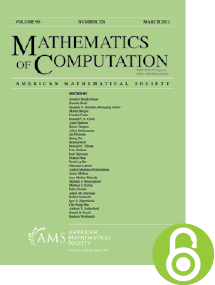An amortized-complexity method to compute the Riemann zeta function
HTML articles powered by AMS MathViewer
- by Ghaith A. Hiary PDF
- Math. Comp. 80 (2011), 1785-1796 Request permission
Abstract:
A practical method to compute the Riemann zeta function is presented. The method can compute $\zeta (1/2+it)$ at any $\lfloor T^{1/4} \rfloor$ points in $[T,T+T^{1/4}]$ using an average time of $T^{1/4+o(1)}$ per point. This is the same complexity as the Odlyzko-Schönhage algorithm over that interval. Although the method far from competes with the Odlyzko-Schönhage algorithm over intervals much longer than $T^{1/4}$, it still has the advantages of being elementary, simple to implement, it does not use the fast Fourier transform or require large amounts of storage space, and its error terms are easy to control. The method has been implemented, and results of timing experiments agree with its theoretical amortized complexity of $T^{1/4+o(1)}$.References
- W. Gabcke, Neue Herleitung und explicite Restabschätzung der Riemann-Siegel-Formel. Ph.D. Dissertation, Göttingen, 1979.
- X. Gourdon, The $10^{13}$ first zeros of the Riemann zeta function and zero computation at very large heights. Available at: http://numbers.compuation.free.fr.
- B. F. Logan, Bounds for the tails of sharp-cutoff filter kernels, SIAM J. Math. Anal. 19 (1988), no. 2, 372–376. MR 930033, DOI 10.1137/0519027
- A.M. Odlyzko, The $10^{20}$-th zero of the Riemann zeta function and 175 million of its neighbors. www.dtc.umn.edu/$\sim$odlyzko
- A. M. Odlyzko and A. Schönhage, Fast algorithms for multiple evaluations of the Riemann zeta function, Trans. Amer. Math. Soc. 309 (1988), no. 2, 797–809. MR 961614, DOI 10.1090/S0002-9947-1988-0961614-2
- Michael Rubinstein, Computational methods and experiments in analytic number theory, Recent perspectives in random matrix theory and number theory, London Math. Soc. Lecture Note Ser., vol. 322, Cambridge Univ. Press, Cambridge, 2005, pp. 425–506. MR 2166470, DOI 10.1017/CBO9780511550492.015
- M.O. Rubinstein home-page, www.math.uwaterloo.ca/$\sim$mrubinst.
Additional Information
- Ghaith A. Hiary
- Affiliation: Institute for advanced Study, 1 Einstein Drive, Princeton, New Jersey 08540
- Address at time of publication: University of Waterloo, Department of Pure Mathematics, 200 University Avenue W, Waterloo, ON N2L 3G1, Canada
- MR Author ID: 930454
- Email: hiaryg@gmail.com
- Received by editor(s): February 11, 2010
- Received by editor(s) in revised form: April 28, 2010
- Published electronically: January 25, 2011
- Additional Notes: This material is based upon work supported by the National Science Foundation under agreements No. DMS-0757627 (FRG grant) and No. DMS-0635607.
- © Copyright 2011
American Mathematical Society
The copyright for this article reverts to public domain 28 years after publication. - Journal: Math. Comp. 80 (2011), 1785-1796
- MSC (2000): Primary 11M06, 11Y16; Secondary 68Q25
- DOI: https://doi.org/10.1090/S0025-5718-2011-02452-X
- MathSciNet review: 2785479


